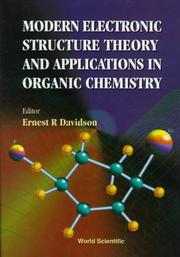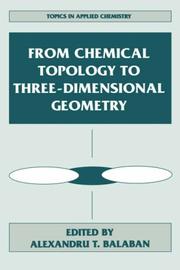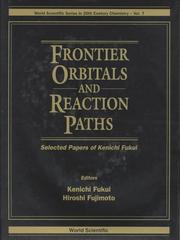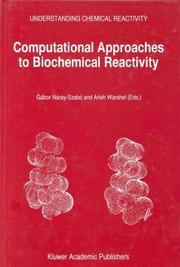| Listing 1 - 4 of 4 |
Sort by
|

ISBN: 9812839755 9789812839756 9810231687 9789810231682 Year: 1997 Publisher: Singapore ; River Edge, N.J. : World Scientific,
Abstract | Keywords | Export | Availability | Bookmark
 Loading...
Loading...Choose an application
- Reference Manager
- EndNote
- RefWorks (Direct export to RefWorks)
This volume focuses on the use of quantum theory to understand and explain experiments in organic chemistry. High level ab initio calculations, when properly performed, are useful in making quantitative distinctions between various possible interpretations of structures, reactions and spectra. Chemical reasoning based on simpler quantum models is, however, essential to enumerating the likely possibilities. The simpler models also often suggest the type of wave function likely to be involved in ground and excited states at various points along reaction paths. This preliminary understanding is n

ISBN: 1280043695 9786610043699 0306469073 0306454629 Year: 1997 Publisher: New York : Kluwer Academic Publishers,
Abstract | Keywords | Export | Availability | Bookmark
 Loading...
Loading...Choose an application
- Reference Manager
- EndNote
- RefWorks (Direct export to RefWorks)
Even high-speed supercomputers cannot easily convert traditional two-dimensional databases from chemical topology into the three-dimensional ones demanded by today's chemists, particularly those working in drug design. This fascinating volume resolves this problem by positing mathematical and topological models which greatly expand the capabilities of chemical graph theory. The authors examine QSAR and molecular similarity studies, the relationship between the sequence of amino acids and the less familiar secondary and tertiary protein structures, and new topological methods.
Molecular structure --- Geometry, Modern. --- Mathematical models. --- Chemistry, Organic. --- Pharmacy. --- Chemistry, Physical organic. --- Organic Chemistry. --- Physical Chemistry. --- Organic chemistry. --- Physical chemistry. --- Chemistry, Theoretical --- Physical chemistry --- Theoretical chemistry --- Chemistry --- Medicine --- Drugs --- Materia medica --- Pharmacology --- Organic chemistry --- Structure, Molecular --- Chemical structure --- Structural bioinformatics

ISBN: 128195568X 9786611955687 9812795847 9789812795847 9810222416 9789810222413 6611955682 Year: 1997 Publisher: Singapore ; River Edge, N.J. : World Scientific,
Abstract | Keywords | Export | Availability | Bookmark
 Loading...
Loading...Choose an application
- Reference Manager
- EndNote
- RefWorks (Direct export to RefWorks)
This book is a collection of selected papers on the Frontier Orbital Theory by Nobel prizewinner Kenichi Fukui (Chemistry 1981), with introductory notes. It provides the basic concept and formulation of the theory, and the physical and chemical significance of the frontier orbital interactions in chemistry, together with many practical applications. The formulation of the Intrinsic Reaction Coordinate and applications to some simple systems are also presented. The aim of this volume is to show by what forces chemical reactions are driven and to demonstrate how the regio- and stereo-selectivities are determined in chemical reactions. Students and senior investigators will gain insight into the nature of chemical reactions and find out how quantum chemical calculations are connected with chemical intuition.
Molecular orbitals. --- Chemical reactions. --- Physical organic chemistry. --- Chemistry, Physical organic --- Chemistry, Organic --- Chemistry, Physical and theoretical --- Reactions, Chemical --- Chemical processes --- Orbitals, Molecular --- Chemical bonds --- Electrons --- Molecules --- Overlap integral --- Quantum chemistry --- Valence (Theoretical chemistry) --- Wave mechanics

ISBN: 1280204966 9786610204960 0306469340 0792345126 Year: 1997 Publisher: Dordrecht ; Boston : Kluwer Academic,
Abstract | Keywords | Export | Availability | Bookmark
 Loading...
Loading...Choose an application
- Reference Manager
- EndNote
- RefWorks (Direct export to RefWorks)
A quantitative description of the action of enzymes and other biological systems is both a challenge and a fundamental requirement for further progress in our und- standing of biochemical processes. This can help in practical design of new drugs and in the development of artificial enzymes as well as in fundamental understanding of the factors that control the activity of biological systems. Structural and biochemical st- ies have yielded major insights about the action of biological molecules and the mechanism of enzymatic reactions. However it is not entirely clear how to use this - portant information in a consistent and quantitative analysis of the factors that are - sponsible for rate acceleration in enzyme active sites. The problem is associated with the fact that reaction rates are determined by energetics (i. e. activation energies) and the available experimental methods by themselves cannot provide a correlation - tween structure and energy. Even mutations of specific active site residues, which are extremely useful, cannot tell us about the totality of the interaction between the active site and the substrate. In fact, short of inventing experiments that allow one to measure the forces in enzyme active sites it is hard to see how can one use a direct experimental approach to unambiguously correlate the structure and function of enzymes. In fact, in view of the complexity of biological systems it seems that only computers can handle the task of providing a quantitative structure-function correlation.
Biochemistry --- Enzyme kinetics. --- Quantum biochemistry. --- Ligand binding (Biochemistry) --- Mathematical models. --- Biochemistry. --- Chemistry, Physical organic. --- Chemistry. --- Biochemistry, general. --- Physical Chemistry. --- Computer Applications in Chemistry. --- Biological and Medical Physics, Biophysics. --- Physical chemistry. --- Chemoinformatics. --- Biophysics. --- Biological physics. --- Biological physics --- Biology --- Medical sciences --- Physics --- Chemical informatics --- Chemiinformatics --- Chemoinformatics --- Chemistry informatics --- Chemistry --- Information science --- Computational chemistry --- Chemistry, Theoretical --- Physical chemistry --- Theoretical chemistry --- Biological chemistry --- Chemical composition of organisms --- Organisms --- Physiological chemistry --- Data processing --- Composition --- Binding, Ligand (Biochemistry) --- Dye-ligand affinity chromatography --- Radioligand assay --- Biochemistry, Quantum --- Biology, Quantum --- Quantum biology --- Quantum chemistry --- Dynamics, Enzyme --- Enzyme dynamics --- Enzymes --- Kinetics, Enzyme --- Chemical kinetics --- Kinetics
| Listing 1 - 4 of 4 |
Sort by
|

 Search
Search Feedback
Feedback About
About Help
Help News
News